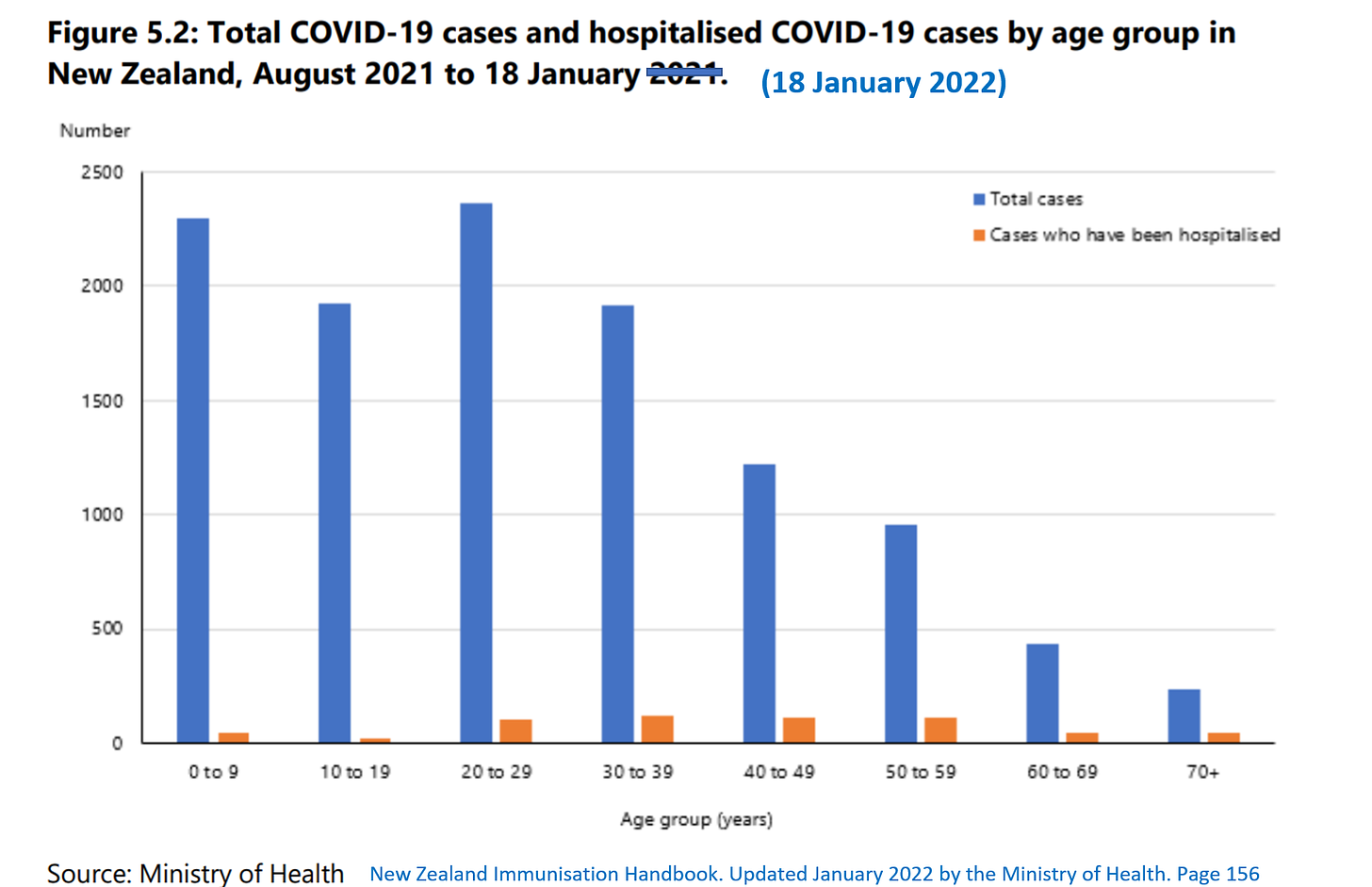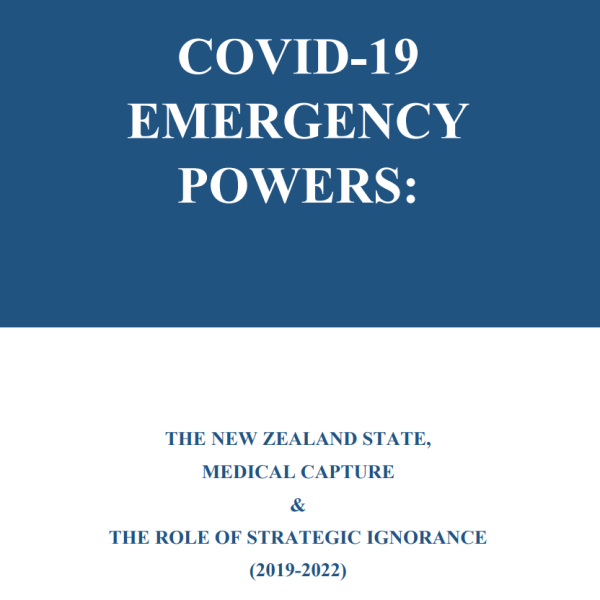Emergency Powers: [5] Case Rate Rhetoric - were the public kept in the dark?
From my April 2022 paper COVID-19 Emergency Powers: The New Zealand State, Medical Capture & the Role of Strategic Ignorance
Chapter 5.
The earliest publications which came out of the Ministry of Health were built on an elimination of all cases rhetoric, by April 2020 elimination was established as the campaign mode. Press releases listed all cases and emphasised on a daily basis, the acceleration and location of cases, and for many months. Because of the stigma of being a ‘case’ there was population level shame attributed to involvement in the case location. The legislation that has driven New Zealand’s hard-line mandates have been based on elimination strategies which necessitated high vaccination rates, in order to ‘eliminate’ the cases.
From the earliest, most of the population were not at risk of hospitalisation and death, but the case rate rhetoric did not provide a safe space for people to question whether a case was a ‘good’ thing. In line with longstanding principles of epidemiology, each case would shift the population (or herd) closer to immunity, and as natural immunity increased, the virus would become less harmful. According to established principles of epidemiology, most of the population could safely become infected, and therefore the most important tactics were to protect the vulnerable. However, this was never a conversation that was undertaken in a public forum.
This strategy of case alarm, or case fear, promoted ignorance in the population.
Yet one of the most senior scientists involved in the campaign, David Skegg, considered in June 2021 that the mRNA provided better immunity than from natural infection. The discounting of the role of natural immunity provides some clue as to the priorities of the modellers and scientists, throughout the 2 years to 2022.
It was known from very early stages that there was a1000-fold difference in risk of death for those over 65, compared to children and young people (CYP) (and here). Most New Zealanders were not at serious risk from COVID-19, and the relatively low infection fatality rate early on in the pandemic, with risk stratified by age.
As with the general population, pregnant women were not at risk of hospitalisation and death unless morbidly obese and with significant complicating factors.
Focussed protection is a fundamental norm of public health, as it aims to protect the vulnerable while permitting not-at risk groups to go about daily life. Early in the pandemic the Great Barrington Declaration (and others) recommended protection of high risk and vulnerable groups to prevent the public health harms of lockdowns where negative consequences may ‘outweigh benefits’.
It is unlikely that the majority of the population would have considered that they were not at risk of hospitalisation or death, based on the Ardern Governments to all appearances, misleading promotional Unite Against COVID-19 Campaign.
A January 2022 Ministry of Health chart (edited out of the April 2022 edition) shows the frequency of hospitalisation following Sars-Cov-2 infection by age group. Hospitalisations were few, and this was in the period when Delta, which was recognised to potentially lead to more hospitalisations and death than Omicron, was the predominant infectious strain. It’s unlikely most of the population would have recognised their risk profile by age group.

The Unite Campaign produced, instead of a broader, balanced perspective, which evaluated risk by age, a tendency across the nation of uniformly (and breathlessly) ascribing equivalent risk to all case numbers. In the two years between February 15, 2020, and January 29, 2022, a total of 18,000 cases were reported and 53 deaths, directly attributed to COVID-19 occurred (accessed February 7, 2022).
The case rate narrative appeared to smooth the way for the Ardern Government to impose the case focussed stamp it out, elimination strategy, ‘Red’ Traffic Light restrictions; implement and maintain onerous and ethically problematic, mandate restrictions. The Unite Campaign continue to promote fear of case numbers, and urge vaccination, even as the scientific literature suggested global vaccination was neither safe, nor effective, and could not prevent ‘cases’. The traffic light system unashamedly privileged those with a current vaccine pass. Government pressure did not lessen with the arrival of Omicron variant.
Throughout Summer 2022 in New Zealand, families were required to accept a medical intervention in the form of a novel mRNA genetic therapy in order to access a vaccine pass which permits them to engage in economic and social life. A vaccine pass provided evidence of a medical intervention -which could not prevent transmission and infection.
The traffic light system was designed to ‘nudge people towards vaccination’. Constant promotion of case numbers and highlighting of places of interest through surveillance and contact tracing strategies, is an element of the behaviour modification nudge science. The nudge strategy was applied to drive the entire population towards isolation and vaccination, rather focussed protection for vulnerable groups.
Risk stratified by age and health status was not a key message in government communications, instead, daily messaging concerned the seriousness of ‘the case’, without drawing attention to personal risk. With sustained ignorance relating to the infection fatality rate, fear in the population of COVID-19 was likely to be over-estimated, particularly from mid-2021 when the infection fatality rate was established in the scientific literature.
However, broader information relating to infection fatality rates were never discussed in press releases, in news items or in the press. In all likelihood, personally considered risk of death from COVID-19 was likely to be disproportionate, compared to the risk of, for example, suicide, which takes the life of 600 New Zealanders annually, or suffering a heart attack, which kills 10,000 New Zealanders annually.
Suicide and heart attacks in New Zealand are at epidemic levels, not COVID-19.
The public’s perception of a health threat is predictive of behaviour and strongly associated with compliance (and here). The state and media have, in concert, promoted ‘case’ numbers, which includes a/symptomatic infection rates and false-positives, promoted negativity and fear.
Fear was directly associated with compliance with policy measures from April 2020. Prime Minister Ardern was confident that Covid policies would create a two-tier society in October 2021. This comment was made when it was evident that the Sars-Cov-2 virus would not severely harm the majority of the New Zealand population, and when harms from the mRNA genetic vaccines and the particular risk from the spike protein were accumulating in the scientific literature.
The scientific literature supports fear messaging in order to secure compliance for increasing restrictions. However the Ardern governments simple slogan ‘case rate’, ‘protect family’ and ‘get boosted’ narratives – overlayed with rights restrictions and an unprecedented barrage of quick-throughput law-making - hints at demagoguery:
‘a natural tendency in representative democracies, a temptation to seduce them rather than convince them’.
While interpretations historically focussed on demagogues who manufactured outrage against an elite, activities central to demagogic activity involves marginalisation of minority communities, and the direction of anger towards the authority of the demagogue to fix or control the situation. Through this the demagogue engages in a
‘concerted effort to create confusion in order to break down established norms of conduct, institutions, and the law.’
For
‘Demagogues thrive on simple slogans, where serious politics requires examination of detail.’
The repetitive rhetoric of ‘case’ receives the lion’s share of Government, media and public attention, not the risk.
It's a very fine line between following the nudging science, and stepping into the territory of a demagogue.
Continue Reading: [6] Elimination at all costs here.
References in full are on the original PDF at TalkingRisk.NZ




